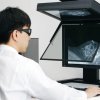As the most common form of cancer among women, breast cancer is an increasingly prominent issue in the medical world. Early detection screening is an important tool in limiting the number of deaths from the disease, however traditional 2D mammograms do not allow any level of depth perception for physicians that need to locate a tumor or micro-calcification cluster. Unlike other parts of the body where tumors may occur, breasts do not contain any bones or other prominent markers that can be used to pinpoint the relative location of the growth.
Fujifilm‘s AMULET 3D mammogram technology, already approved and in use in Europe, is said to have addressed some of these concerns. Fujifilm employs NVIDIA’s high performance K2000D GPU in its AMULET system, claiming that the need for reliable performance, and high quality stereoscopic imaging led to the partnership. The 3D technology works by taking two high resolution (X-ray) images at 0 degree and 4 degree angles, and combining them into one image, mimicking the stereoscopic vision of the human eyes, thus enabling accurate depth perception. The composite image is displayed on a 3D clam-shell display, which Fujifilm claims allows physicians to accurately locate the precise location of any detectable tumor. According to the company, the X-ray dosage required for the 3D imaging to work is only 1.3-1.5 times larger than standard 2D mammography, however the increase in detail is said to be remarkable. Hopefully, as this technology is brought stateside, it’s acceptance and use in hospitals around the country will significantly increase tumor detection efficiency, and help physicians and patients get the most out of each screening.
“Fujifilm’s AMULET is the first 3D mammography tool that is based on stereoscopic imaging. AMULET captures images at 0 degree and 4 degree views, mimicking the left-eye/right-eye perspective employed in stereoscopic 3D filmmaking, which allows the entire breast to be scanned and evaluated with an unprecedented level of depth. The resulting image is displayed on an innovative 3D stereo clamshell monitor display, and doctors wear 3D glasses upon review.
“When developing this new mammography solution, we included NVIDIA Quadro GPUs under the hood to make it as high-powered and efficient as possible,” said Akira Hasegawa, Director, Medical Research, Fujifilm. “NVIDIA’s Quadro K2000D delivers the high image quality that doctors demand to derive accurate reads, and the multi-monitor support that is essential for our 3D clamshell display configuration. Plus the fact that we can power a multi-display AMULET system with just one GPU ultimately means that we can provide a simpler and more affordable solution.””
source:Fujifilm
AMULET: Fujifilms’s New Diagnostic Mammography Tech

